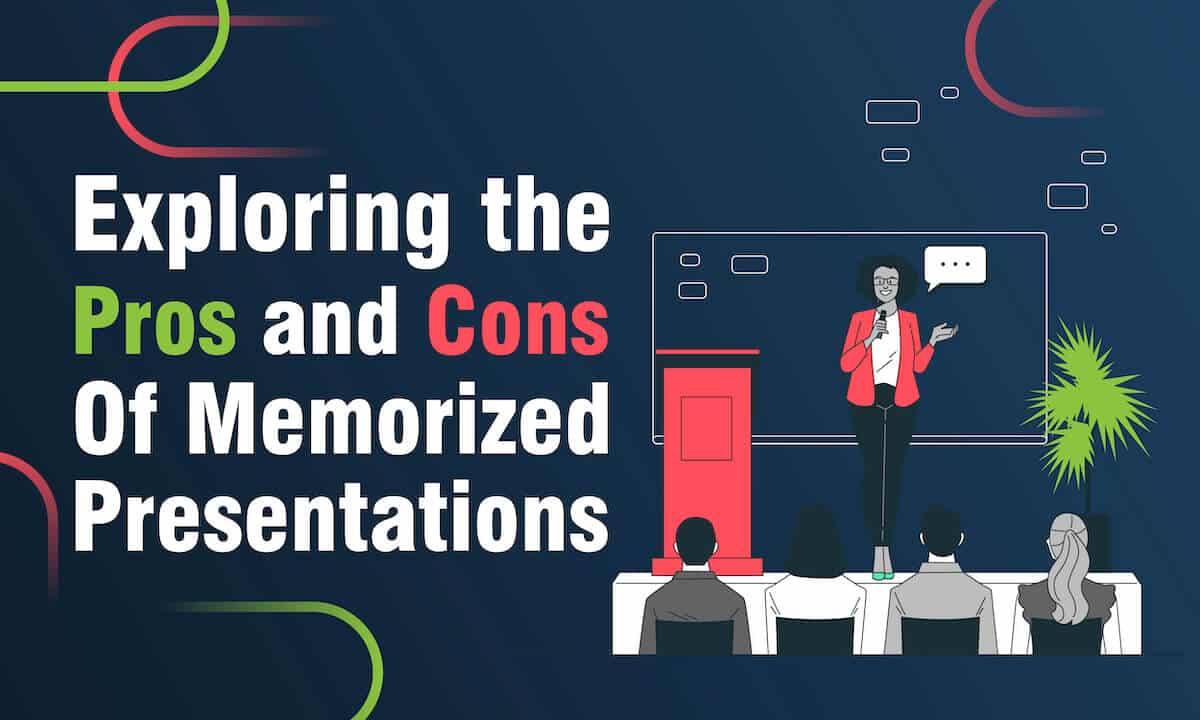Acing your presentation will result in the following – an approved business idea, lead conversion and sale, and getting people up to speed with a concept.
So, you need to work hard to create an effective presentation to deliver important information to people as intended. One of the key factors that will assist you in this process is memorizing the material.
Memorized speech is the rote recitation of texts that the presenter has committed to memory, and it has its positives and negatives.
So, let’s delve into what it means to learn by rote, how effective it is in presentations (advantages and disadvantages), and if there is anything better you can do than memorizing material for a successful presentation.
What is a Memorized Presentation?
It is the process where you learn the speech/material in your presentation and present it without the help of your notes.
Upsides of Memorizing the Presentation
Learning the material in advance has its advantages. It can give you leverage over other methods of recitation (impromptu, manuscript).
1. You get more time to make eye contact
One of the best advantages of learning your presentation is that you can completely face your audience and make eye contact consistently. You get more time to scan your audience and establish rapport by locking glances.
Why is it so important?
Because it is the quickest and easiest way to build connections, and you wouldn’t want to be the person who keeps looking in the notes or on screen when presenting. It will make your presentation very impersonal, and you will miss out on the magic of forging interpersonal relationships in that crucial duration.
2. Less use of filler words and distracting speech
When you are prepared in advance, you know the content beat by beat, including the sequence, the words, and the entire material. It frees you from the space of not knowing and having to fill up the speech with filler words (um, like, you know) or accidentally using them.
In the process, you might need to go back to your notes or PPT to recall, creating this silent space (use of distracting speech or being quiet) which is an embarrassment for both the audience and the presenter.
3. You look like an expert
In an ideal situation, the memorized speech sounds like an off-the-cuff statement by an eloquent presenter and an organized thinker. It gives you the space to speak with conviction, control, and confidence since you know the entire content like the back of your hand.
The presenter can’t get sidetracked with the content and can deliver the message exactly as intended. Also, people will feel more confident in your knowledge of the content.
4. Appropriate use of space and body language
Memorizing the presentation will free you from being restricted to personal notes and PPT screens. So that gives you ample time and space to move around the stage and be mindful of your body language and gestures. If you are using visual aids in your presentation, then you are more at an advantage.
However, to use this to your benefit, try to memorize the vocal cues (the varied pitch, tone, volume, and pace), facial expressions, and gestures, as well, to avoid the risk of making your presentation flat and dull.
Downsides of Memorizing the Presentation
Let’s go through some of the reasons that make memorized presentations a bad idea.
1. Forgetting the content
Okay, let’s see. Why does anyone memorize a presentation?
The purpose is to remember everything and not miss any key point in the presentation.
But as it stands, memorization might help with short content, like a wedding toast speech. Presentations are complex and lengthy, and the longer they are, the harder they are to remember word for word.
And you will be more likely to forget your speech. So, the very reason for which you wanted to do this in the first place might not be fulfilled, and the situation becomes paradoxical.
Also, a format like that has no personality. When you are too focused on remembering everything, a lot gets lost mid-way. One of the quickest responses would be from your audience disengaging from you as the speaker, and it’s very difficult to get people back from that stage.
2. Unnatural and lack of spontaneity
The primary goal of your presentation would be to engage your audience to elicit the desired result from the presentation. How engaging and interesting the presenter looks reading the content word for word?
How inspired or excited do you think the audience is sitting through that presentation?
A memorized presentation to the T might mean you stand the risk of sounding too rehearsed, resulting in a monotonous tone. It lacks the passion and authenticity of a good delivery from someone with presentation skills.
3. Going in autopilot mode or not being mindful
When you have memorized everything, you can quickly move into an autopilot zone, relaying everything like a parrot. Also, the process of recalling makes you not mindful of the environment.
Such a thing will make you miss out on emphasizing the relevant and essential points and doesn’t sound too authentic.
4. A lot of work
A presentation is a long document, and not like a 2-minute speech at some political event or wedding. Memorizing the entire thing is a big and tedious task and will require a lot of effort. And it’s not just the texts you will have to remember for effective relaying – you need to be mindful of the delivery as well.
Otherwise, your presentation will become too insipid for anyone to engage with. So, including everything, learning by rote is too much effort, and the benefits do not level the risks associated.
5. Discomfort with any changes
Any changes in the audience or situation might become discomforting and distracting as a lot of energy is focused on recalling everything right. Any alterations and interruptions might sidetrack you enough to lose track of the content, and getting back from that stage could be troubling.
Imagine this happening just even twice in your presentation.
Also, if you suddenly start an ad-lib, the audience will notice the change of delivery and the transition that took place. And it will make them see that something is off and wrong.
5. It is wise to practice
Where memorization is lacking, practice will fill all the gaps. The more you practice, the more you will be learning things as a byproduct, and you will realize, eventually, those two are very different.
Practicing the content will help you cover things like specific words you will say, pauses, gestures, etc. On the other hand, memorization is committing the information to memory to be recalled later.
Don’t try to learn the entire manuscript by heart – rather, go with the outline. Practice so you can effortlessly recall the order and content of your main points.
However, there are specific things that you could memorize, like the crucial statistics of your presentation (if you have to), opening and closing speech, etc., where you don’t need to refer to your notes again and again.
To Sum it Up
Memorizing a presentation has its upsides and downsides. On the one hand, it will give you a sense of knowingness; on the other, you stand the risk of looking too robotic and predictable.
So, it is wise to draw the line in between. You can memorize parts of your presentation and rely on practice and strong presentation skills to cover points.
Rather than relying on memorizing, you should try learning your presentation cold. Meaning that taking time to craft the sequence of your content and rehearsing it so much that you can recite it backward if needed. Practicing your presentation like this will help you cover all the loopholes and negatives of memorization, rendering you with only the pluses.
Work on creating solid slides that give you a peek into all the relevant points and transitions and use them to your advantage in your elocution skills. And you are good to go for a rocking presentation!
Looking For Powerpoint Design Agency?
Call Pursho @ 0731-6725516
Telegram Group One Must Follow :
For Startups: https://t.me/daily_business_reads
#Exploring #Pros #Cons #Memorized #Presentations




